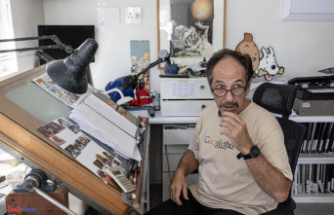Titles as the last film or paper moon consolidated it in the industry as one of the most significant directors of the new Hollywood litter, an installed cinema in the counterculture of the 70s in the United States. Peter Bogdanovic, died at 82, was a prolific and respected filmmaker in his time but also affected by personal scandals that threatened to derail his race.
As François Truffaut a decade before, Bogdanovich began on the other side of the trench, as a film critic. Afterwards, in 1964, Roger Corm hired him to collaborate as a screenwriter and assistant in Los Angeles of Hell, of 1966. He gave such a good result his raid that was launched in 1968 (Targets) to give with the precise key three years later In the last film, a commercial and critical success that flourished loaded with Oscar nominations, eight in total.
It is, for many critics, the Summit work of a filmmaker who became considered as "the new most exciting director of the moment in the United States", remembered by comedies as round as what happens to me, doctor? And by directing cher with mask mask.
Bogdanovich was admired in the film industry not only for his role behind the cameras but for his touched almost all the clubs: producer, screenwriter, actor and one of the most important cinema historians at the time. For David Thomson, the British critic, "Bogdanovich was a valuable critic of French inspiration that insisted on management as author, so much that many Americans began to take the directors more seriously from what he wrote."
Bogdanovich was an obsessive of the seventh art, a genre nerve who came to consume 400 films a year accommodation of the 1960s also responsible for the film program of the New York Modern Art Museum. At that time he gave tributes to him venerated him Orson Welles, Howard Hawks or John Ford, of whom he later wrote a book. Europe was the other film school of him. Influenced by the Nouvelle Vague and the work of Truffaut, Godard and Chabrol, he launched himself to propose his own version of that fresh and at the same time intellectual film in the US.
Thus came the last film, shot in black and white and focused on the life of a small town in Texas, connected with the American public in an intense way. "He told many people a lot," Bogdanovich recognized in an interview years later. It was the first of a hit of successes, along with what about me, doctor? And paper moon - interpreted by Ryan O'Neal and the daughter of him Tatum - who gave him the "Golden Chico" poster of Hollywood.
It also meant the beginning of its constant presence in the American tabloids. During the filming of the last movie he had an adventure adultera with the protagonist actress, the debutante and model Cybill Shepherd. The relationship flowed into his divorce from Polly Platt, the ducker in the shade of her race and mother of her two children. Bogdanovich remembered that this was a time when he "irritated many people."
It was not corrected soon. In 1981, Bogdanovich began to go out with Dorothy Stratten, a model of Playboy to which he directed at all laughed. The issue ended in tragedy. She was killed by her husband, Paul Snider, who at the same time took away her life. The scandal hit the film full. The Director himself tried to distribute it with little success, abound to declare bankruptcy. Part of guilt, he said, Hugh Hefner had.
But Bogdanovich persevered in his infinite love for cinema, accepting even papers as an actor. He was part of the series Sopranos de Hbo and put his voice on a Tarantino Quentin tape, Kill Bill, among many other jobs that he continued to do almost until the end of his days.
Born on July 30, 1939 in Kingston, New York, Bogdanovich was the son of a Serbian painter and an Austrian immigrant. The fascination of him for the cinema was very early. With 12 years he began to keep chips from each film that he saw and saved them until 30, kneading a collection of more than 5,000. At age 16 he was aimed at classes of interpretation and, with 29, directed his first tape starring Boris Karloff and produced by Cormman, the man who knew how to understand the enormous talent he had before him.
His childhood was not free of drama. The memories of him from the family home of him were loaded with melancholy and silence, marked by death an older brother whom, being a baby, a pot of boiling soup fell over. The passion of him on the big screen helped him overcome that loneliness. The teachers of him ended up for his friends. In his methodical and constant dissection of the geniuses of the time he established with Alfred Hitchcock and Orson Wells, from whom he recorded hours of interviews
Their latest works include a comedy mess in Broadway (2014), and a documentary about Buster Keaton, The Great Buster. Many were the stretches of him but his legacy in the history of cinema is far above them.
Date Of Update: 06 January 2022, 16:07











